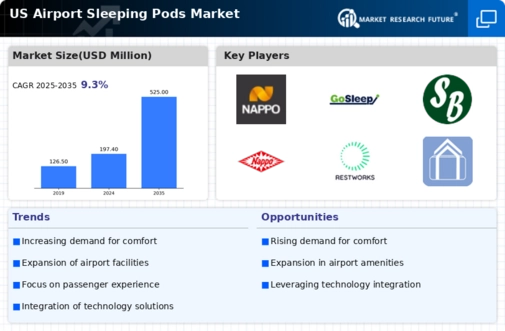The airport sleeping-pods market in the US exhibits a dynamic competitive landscape, characterized by a blend of innovation and strategic partnerships among key players. Companies such as Minute Suites (US), YOTEL (GB), and Sleepbox (RU) are at the forefront, each adopting distinct operational focuses. Minute Suites (US) emphasizes customer experience through its expansion into more airports, enhancing accessibility for travelers seeking rest. YOTEL (GB) leverages its expertise in hospitality to integrate technology into its sleeping pods, offering a seamless booking experience. Sleepbox (RU) appears to focus on modular designs that can be easily deployed in various airport settings, thus catering to diverse traveler needs. Collectively, these strategies contribute to a competitive environment that prioritizes convenience, comfort, and technological integration.
Key business tactics within this market include localizing manufacturing and optimizing supply chains to enhance operational efficiency. The competitive structure is moderately fragmented, with several players vying for market share. This fragmentation allows for a variety of offerings, catering to different traveler demographics and preferences. The influence of key players is significant, as they set benchmarks for service quality and innovation, which smaller entrants often strive to emulate.
In October 2025, Minute Suites (US) announced the opening of new locations in major airports, including Los Angeles International Airport (LAX) and Hartsfield-Jackson Atlanta International Airport (ATL). This expansion is strategically important as it positions the company to capture a larger share of the growing demand for short-term rest solutions among travelers. By increasing its footprint in high-traffic airports, Minute Suites (US) enhances its visibility and accessibility, potentially leading to increased revenue streams.
In September 2025, YOTEL (GB) unveiled a new line of eco-friendly sleeping pods designed to reduce energy consumption by 30%. This initiative aligns with the growing trend towards sustainability in the travel industry. By prioritizing environmentally friendly practices, YOTEL (GB) not only appeals to eco-conscious travelers but also differentiates itself in a competitive market increasingly focused on sustainability.
In August 2025, Sleepbox (RU) launched a partnership with a leading technology firm to integrate AI-driven booking systems into its sleeping pods. This move is likely to enhance user experience by streamlining the reservation process and providing personalized recommendations based on traveler preferences. Such technological advancements may set a new standard in the market, compelling competitors to innovate further.
As of November 2025, current trends in the airport sleeping-pods market are heavily influenced by digitalization, sustainability, and the integration of AI technologies. Strategic alliances among companies are shaping the landscape, fostering innovation and enhancing service offerings. The competitive differentiation is expected to evolve, shifting from traditional price-based competition to a focus on technological innovation, customer experience, and supply chain reliability. This transition suggests that companies that prioritize these aspects will likely gain a competitive edge in the future.
























Leave a Comment